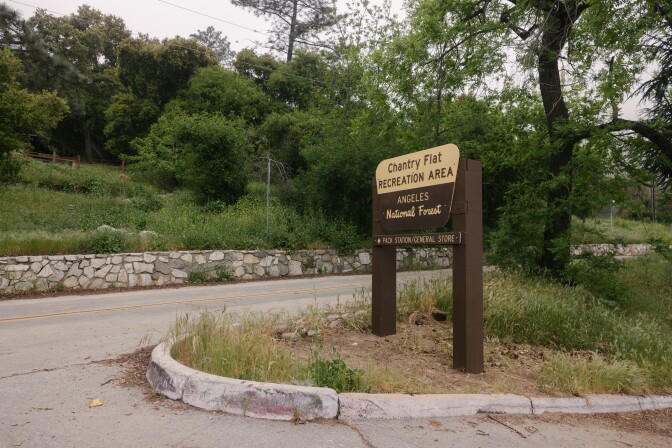Topline:
After several years of closure following the Bobcat Fire in 2020, the U.S. Forest Service will open the Big Santa Anita Canyon -- which includes the Chantry Flat recreation area -- to the public on Oct. 2.
The backstory: The re-opening follows thousands of hours spent by several volunteer groups to clear trails that were damaged in the fire and subsequent atmospheric rivers.
Historic cabins: The Bobcat fire tore through about 116,000 acres of the San Gabriel Mountains in 2020. It destroyed 171 structures and resulted in the evacuation of residents in Sierra Madre, Monrovia, Bradbury and Duarte.
The fire also destroyed 17 primitive cabins in Big Santa Anita Canyon, many of them more than 100 years old. The Sturtevant Camp cabins are relics from the great hiking era of the early 1900s. Now about 60 remain, although there are hopes to rebuild some of the lost cabins.
Know before you go: We have a lot more information and tips on the reopening. Keep reading!
After years of closure following the Bobcat Fire in 2020, the U.S. Forest Service will reopen the Big Santa Anita Canyon -- which includes the popular Chantry Flat recreation area -- to the public on Oct. 2.
The re-opening follows thousands of hours spent by several volunteer groups to clear trails damaged in the fire and made worse by subsequent atmospheric rivers.
Estephany Campos, with the Forest Service, told LAist that volunteers young and old have come from all over the region and built a community around the trail restoration work.
“For me it’s always about working in community and that’s how things get accomplished on our forest,” Campos said.
Popular Chantry Flat hiking area to reopen years after Bobcat Fire. Here’s what to know
Erik Hillard was one of the many volunteers who answered the call. In the last few years, he traveled frequently to the burned area over to rehabilitate the Gabrielino and other trails.
“It’s the winters where water comes down and moves all kinds of sediment that cause a lot of damage. And the area is really changed dramatically when we get our heavy rains,” said Hillard, Board Director of the volunteer group Lowelifes Respectable Citizens’ Club.
It’s been rewarding work, he said, and like many others Hillard is looking forward to getting that part of the Angeles National Forest opened back up to the public.
“Everybody is out there to give back to the forest, to improve it. Some people would say that ultimately maybe I’m a bit selfish [because] I’m improving the trails for me to be able to use,” Hillard said.
Eric Mulfinger, a retired math teacher and volunteer with the Restoration Legacy Crew, said the work is at times therapeutic.
His crew only uses hand tools to work on the trails, including Japanese kataba saws, which make quick work of fallen tree limbs.
“We also use sledgehammers from time to time,” Mulfinger said. “Sometimes the boulders are just too big and we’ll try to smash them. And I always joke that that's the perfect therapy right there. ‘You’ve had a tough week? Go take it out on this boulder.’”
Damage from Bobcat Fire and rain
The Bobcat fire tore through about 116,000 acres of the San Gabriel Mountains in 2020. It destroyed 171 structures and resulted in the evacuation of residents in Sierra Madre, Monrovia, Bradbury and Duarte.
The fire also burned down 17 primitive cabins in Big Santa Anita Canyon, many of them more than 100 years old. The cabins are relics from the great hiking era of the early 1900s. Now about 60 remain, although there are hopes to rebuild some of the lost cabins.
Gary Keene, President of The Sturtevant Conservancy said there have been some dramatic changes in the landscape, some of it brought on by the fire and some of it by the restoration work.
For one, a bridge that hikers might remember at the bottom of the paved path from the Chantry Flats parking area is gone.
“The winter storms last year blew that practically out of the canyon. It’s pretty extraordinary what happened down there. People... who have familiarity with it, are just awestruck,” Keene said.
At times, the work felt immense and never ending.
“You clear a section of trail and think you’ve done good. And then you come back the next week and do it all over again,” Keene said. “I still think one of these days we’re going to make the t-shirt that says ‘Team Sisyphus.’ That’s been the work.”
While Keene said he’s happy the public will soon be able to enjoy the area again, there are some things to keep in mind:
Know before you go (information courtesy of the USFS):
- Situational Awareness: The Big Santa Anita Canyon/Chantry Flat area still continues to recover from wildfire. Be aware of your surroundings. Here are some additional safety tips.
- Visit the Angeles National Forest website at: www.fs.usda.gov/angeles, call 626-574-1613, or stop by one of their offices or visitor centers.
- Fire danger is EXTREME. No grills (charcoal or gas). No smoking.
- Please use only official Forest Service-designated trails. By the reopening date of Oct. 2, you will be able to see a trail map on information boards in the parking lot, as well as on the Angeles National Forest website.
- Restrooms are only available near the parking lot, unless hiking to Spruce Grove (where there is a another bathroom.) Plan accordingly.
- Pay close attention to “No Parking” signs. There is no parking along the main road into the site or in front of the gate by the road/trail that leads to Roberts Camp. Why? (Emergency vehicle access for medical emergencies or wildfire responses.)
- Follow Leave No Trace principles.
- More volunteers are needed: If you would like to volunteer, visit www.fs.usda.gov/main/angeles/workingtogether/volunteering
What trails are open or closed?
CLOSED TRAILS:
- Zion Trail
- Sturtevant Trail closed to Mt. Wilson
- Anything north of Sturtevant Camp is closed to Newcomb Pass
OPEN TRAILS:
- First Water Trail
- Upper and Lower Winter Creek trails
- Sturtevant Loop to Sturtevant Falls
- Gabrielino National Recreation Trail from Chantry Flats to Sturtevant Camp

















